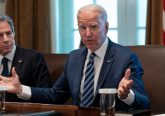The United States has a consistent Strategic Culture, centered on a sense of exceptionalism, values-driven foreign policy, casualty aversion, as well as strong leadership. These features reflect in its space policy and ambitions, where the US has cooperated with other nations but assumes a position of natural leader. It remains to be seen how this role will evolve – although the sense of exceptionalism may endure – as new actors, including private companies, make their way into space.
Why Strategic Culture Matters
Developed in the 1970s, “Strategic Culture” is a concept used to analyze the role of culture and national idiosyncrasies in shaping national security decisions. As with many paradigms developed during the Cold War, it emerged in the context of superpower competition and to serve U.S. decision-makers to make better sense of Soviet Union’s military strategy.
Strategic Culture is the set of beliefs, perceptions, historical baggage, and the geopolitical vision that shape a country’s foreign policy, its strategic choices, and its position in international relations. The explicit insight into how national values affect strategy has made Strategic Culture an unconventional paradigm for game theorists, who harbor an understanding of rational decision-making based on mathematical models of gains and losses. Strategic Culture is an enduring framework and it is not something that changes with each election cycle. Innovation and change take place in longer time frames, as fluxes in domestic politics and in global norms compel strategic cultures to adapt and evolve.
Over the years, Strategic Culture has demonstrated its analytical value. Increasingly, it is used as a framework to understand and predict diverse security issues, such as the use and acquisition of weapons of mass destruction, cyberspace security, or its impact on culture and transformation processes in the military. History and culture often appear too abstract for military establishments, but it is critical to take them into account because culture shapes security, strategy, and behavior. Theorist Edgar Schein defined culture as an abstraction, yet noted that “the forces that are created in social and organizational situations that derive from culture are powerful. If we don’t understand the operation of these forces, we become victim to them.” Strategic Culture therefore informs us about what shapes the American way of war, Russian strategic thinking, and so on.
Strategic Culture should not be defined as an all-encompassing explanation for foreign policy. Instead, it is a lens through which to analyze state behavior and threat calculus. Importantly, sources of rationality are contingent on differences in moral reasoning, and rationality means different things at different times and in different cultures. Professor Kerry Kartchner stated that “cultural scripts can determine what is considered ‘rational’” and I previously theorized that the emotionality of states is crucial in understanding their strategic culture. Culture is ingrained within each of us and is strong enough to persist even when situations change such as when new states emerge or new issues – including climate change or nuclear war – come to the forefront of the agenda. People are socialized from an early age into a particular way of thinking, which will influence their priorities and solutions to problems.
Applying Strategic Culture Analysis to the U.S. Space Program
The United States is a country with a highly consistent strategic culture and it also possesses the world’s most advanced space program. The former has significantly shaped the latter, representing an interesting case study.
Tenets of U.S. Strategic Culture and Space Policy
Insularity has become a defining element of U.S. strategic culture resulting from its geography and an implicit assumption that wars are always fought on other distant lands. Major Russell A. Moore argues that “the US has had the luxury of choosing how it will participate in a conflict,” because its borders were never seriously under threat, and that “the US is not inclined to prepare seriously for the actual conduct of war.” Additionally, the United States maintains a strong sense of exceptionalism and a strong rhetoric centered on liberty and casualty aversion. When war was inevitable, it was justified almost in divine terms. As Moore continues: “…use of force must be portrayed as a crusade for values.” The U.S. strategic culture is also shaped by its unique history, abundant natural and financial resources, overwhelming optimism, and idealism.
This historical strategic culture was shaken to its core during the Cold War, when the Soviet Union became capable of conducting devastating nuclear strikes on U.S. territory, which ceased to be a sanctuary. This led to a fundamental strategic change as the US and USSR accepted the concept of Mutually Assured Destruction (MAD), which was, and is still, alien to the American historical strategic culture because it effectively embraces vulnerability. In practice, MAD never became part of America’s strategic doctrine and it can be considered an artifact of a set of historical circumstances, including, among others, the general public attitudes against the military during the Vietnam War, which complicated the possibility of making expensive improvements to the military arsenal. Since then, different U.S. administrations have tried to make even the concept of MAD obsolete with the development of ballistic missile defense systems, culminating in the 1980s with the so-called “Star Wars” project of President Reagan aimed at deploying a global shield in space against nuclear ballistic missiles. This concept was unrealistic and was never implemented, but it has not disappeared from the U.S. military space culture, and it was considered again at a much lower scale at the end of the 2010s against North Korean nuclear threat.
All these features appear in U.S. space policy.
The Monroe Doctrine and Space Policy
The Monroe Doctrine became the norm for American foreign policy in 1823 as the US was trying to separate itself from problems in Europe and minimize the risk of future colonization attempts in the Americas. This isolationism gave rise to a sense of American exceptionalism – being distanced and different from Europeans – that endures today. Both individualism and the anti-colonial views that sprung from this era form the basis of a strong national pride, which is evident in America’s attitude toward space policy: the US has refused to sign some treaties or treaty proposals that have some support among other space-faring nations. Its withdrawal from the Anti-Ballistic Missile Treaty in 2002 further aggravated concerns that the US would move forward with space-based missile defenses. The most recent example came at the 2015 Conference on Disarmament, where China and Russia proposed the “no first placement” initiative (the so-called PPWT), calling on nations not to place weapons in space, an addition to a draft treaty that would outlaw the weaponization of space (CD/1985). In a vote of 126 in favor to four against, with 46 abstentions, the US voted against asking the UN General Assembly to urge an early start on updating the draft treaty.
However, while shying away from international commitment in this form, the US simultaneously makes “the peaceful use of outer space,” a key principle in its National Space Policy. Although the US has cooperated with other states in space on the International Space Station (ISS), NASA tends to develop deep space explorations in a spirit of leadership, where the US is the natural leader of international alliances around goals chosen by the US. This has been the case for the ISS, which was proposed to U.S. allies by President Reagan in the 1980s, and to Russia by President Clinton in the 1990s. The same dominant approach could be expected for human missions to the Moon and Mars, which NASA plans to propose to other states, but with clear American leadership in mind. Some countries do not appear inclined to accept this scheme, and China has already stated that it will independently send humans to the Moon in the 2030s after having completed its own space station in the 2020s. The United States considers itself a natural leader for deep space exploration in part because of Strategic Culture: the “Frontier Spirit,” which was at the core of the U.S. westward expansion in the 18th and 19th centuries has an outer space successor, the “High Frontier.”
Casualty Aversions and Space Policy
A common perception among other nations is that the US is unwilling to use force in situations where there may be casualties. Military interventions are usually seen as a last resort in situations deemed absolutely vital by the US. This aspect of U.S. strategic culture is known as casualty aversion. This characteristic ties in with the American traditional reliance and emphasis on technology, which is a way of sparing the lives of American troops. Casualty aversion gained traction following the Vietnam War, and later during the 1990s, when the US fought wars that were largely considered for secondary, even tertiary interests – Somalia and Kosovo, for example. The Powell Doctrine was in a way a further reflection of the desire to minimize U.S. casualties by using overwhelming force. Generally speaking, this notion of the US as casualty adverse has become entrenched in the minds of adversaries and allies, to the point that a senior British officer considered it a weakness and stated that in future wars, the UK might need to work around “the constraints imposed by this American aversion to casualties.” In outer space, US aversion to casualties can also be noted, for example, when the US participated in the United Nations Office for Outer Space Affairs (UNOOSA) Agreement on the Rescue of Astronauts, the Return of Astronauts and the Return of Objects Launched into Outer Space, in 1967.
Ambivalence in the Applicability of International Law
The US was the catalyst for the adoption of a plethora of international treaties and rules after World War II, yet there is a perception that it may ignore its commitment to this legal regime when not convenient. The actions of the US are at times guided by the belief that one can drop the rules when it is better for the greater good, or when the rules do not serve the greater good. For example, even though the US was instrumental in establishing the International Criminal Court, in 2002 it withdrew from the UN agreement that created it and began a diplomatic effort to make the U.S. military immune from its writ.
Covertly, the US is active in several countries relying on space navigation and a vast array of reconnaissance satellites, which can see into other countries from outer space, to assist its activities on Earth. Cold War fears led the U.S. Air Force to develop the MOL program between 1963 and 1969. This program included reconnaissance activities, such as the development of a system that would take photographs of USSR territory from space. Though that program was never completed, an unverified press report claims that the US is planning a triple-canopy space shield that will stretch from the stratosphere to the exosphere and will be patrolled by drones (Global Hawk and X-37B drones) with missiles. If true, the dual-use nature of this technology may eventually raise issues for international law; it can also add further impediments to current efforts to develop legal regimes against weaponization in space.
International Cooperation and Space Policy
American leadership in space is compatible, of course, with cooperation, although U.S. strategic culture will necessarily limit its extent. One of the most obvious instances of U.S. international cooperation for peaceful space purposes is demonstrated by the ISS. Aboard the ISS, 15 countries cooperate, sharing “international flight crews, multiple launch vehicles, globally distributed launch, operations, training, engineering, and development facilities; communications networks, and the international scientific research community.” Such collaboration is important and may outweigh the strategic cultures of many nations, including the US and its inclination for unilateral action. Ultimately, cooperating in space allows several countries to work together to expand technological and scientific knowledge in a borderless arena and consequently transcend political strains. Nevertheless, the US voted against China becoming a partner on the ISS, citing national security concerns, showing that competition and mistrust cannot be overcome entirely for the sake of scientific progress, and U.S. national interests can overrule cooperation.
The Way Forward
Several issues will require more engagement from the US to help maintain peace on Earth, including seriously engaging in discussions of prevention of an arms race in outer space.
Currently, the US is among the few countries to vote against the Proposed Prevention of an Arms Race in Outer Space Resolution (PAROS). Additionally, the US occasionally feeds uncertainty with actions that leave other players puzzled, such as the secret missions of X-37B, a military plane that can be tracked from the ground but whose precise orbit is undisclosed, as is its mission’s purpose. Such actions, combined with the reluctance to join PAROS, and the larger context of U.S. space policy, amplify the concerns of other countries.
It is important to recall that in 2006, the U.S. National Space Policy under the Bush Administration clearly reaffirmed that:
“The United States will oppose the development of new legal regimes or other restrictions that seek to prohibit or limit U.S. access to or use of space. Proposed arms control agreements or restrictions must not impair the rights of the United States to conduct research, development, testing and operations or other activities in space for the US national interests.”
In 2010, the U.S. National Space Policy under President Obama stated that the US would:
“Pursue bilateral and multilateral transparency and confidence-building measures to encourage responsible actions in, and the peaceful use of, space. The United States will consider proposals and concepts for arms control measures if they are equitable, effectively verifiable, and enhance the national security of the United States and its allies.”
The language in the latter document suggests a departure from the earlier approach; however, it should not imply the US is ready to compromise its interests in space for treaties that do not meet its criteria of acceptability. In December 2017, President Trump amended the Obama Administration’s space policy with a Memorandum on U.S. human space exploration. The most important change is expressed in a 63-word text that sets the objective for the US to lead “…the return of humans to the Moon for long-term exploration and utilization, followed by human missions to Mars and other destinations.” On the topic of international law and cooperation, the position of the Trump administration remains to be clarified.
That said, other persistent tenants of U.S. strategic culture, such as casualty aversion, the pursuit of freedom and progress, and the use of outer space for “peaceful purposes” remain guiding principles of U.S. space policy, across administrations. The challenge for the coming decades will be to skillfully balance the U.S. claim to leadership in space with openness for collaboration on an arms control treaty.
It is crucial for the US to join current initiatives to prohibit the weaponization of space because rule-based regimes can create predictability, cooperation, and sustainability of outer-space activities. Geopolitical doctrines of deterrence alone cannot guarantee peace in outer space indefinitely. The US should equally change its posture with regard to the Russian-China PPWT proposal because it is a step toward a rule-based regime, and not dismiss it as “inherently flawed.” In the past, the United States signed, ratified – and at times, co-initiated – treaties (including the Outer Space Treaty), which were treaties of principle. With the PPWT, its claims for rejection reside with the lack of verification mechanisms but this was not an issue it raised as it signed the Outer Space Treaty. The refusal to start negotiations is a roadblock for future efforts. There are pertinent criticisms related to the PPWT, such as its unclear definitions of “use of force” or “outer space object,” or the lack of meaningful discussion of space debris issues, or the issue of ground-based assets. However, this could be an opportune moment to start discussions of a multilateral treaty.
The US has historically pooled resources and mobilized other nations around efforts for international peace and security. A century ago, it played a critical part in creating the League of Nations, and later the United Nations. The cooperative ethos in U.S. strategic culture, however, does not preclude ambitious leadership, nor does it mean placing others’ interests before the interests of the United States. Eventually, this may push the US to negotiate a future weaponization treaty in a way that fits its national security priorities; whichever path it takes, it will be important to recognize that such a treaty would ultimately be in the interest of its national security. Finally, and consistent with U.S. strategic culture, the determination to maintain leadership in outer space is also tied to leadership in innovation and competitiveness.
In terms of current U.S. space ambitions, as mentioned above, President Trump and his advisors have demonstrated support for deep space exploration, such as the Mars mission, alongside a “rapid and affordable” return to the moon. This objective is, in the opinion of some commentators, a return to Bush’s policy which had also focused on a return to Moon, although the objective appears for now inconsistent with the amount of funding allotted to NASA, which saw its budget slightly cut. However, early indications suggest that the current U.S. administration is seeking to monetize space, and encourage more partnerships with the private sector. The new administration appears to be advocating the development of privately operated space stations and the “large-scale economic development of space,” similar to policies advanced under the previous U.S. administration of President Obama. In 2010, President Obama announced his support for more reliance on private companies to launch astronauts, a decision then met with significant resistance.
Although it remains unclear precisely what role U.S. strategic culture will play in shaping future space policy, it is likely that a sense of U.S. exceptionalism and the use of space to protect U.S. interests in vital circumstances will remain. The current behavior of the United States, insisting on issues such as one-hundred percent verifiable treaties is a manifestation of America’s inherent need to eliminate vulnerability, as well as a strong desire to set the rules of the game. The question for global security is whether this exceptionalism will be perceived benignly by the rising space nations, potentially setting the stage for additional tension.
This article was originally published in the Columbia Journal of International Affairs.






